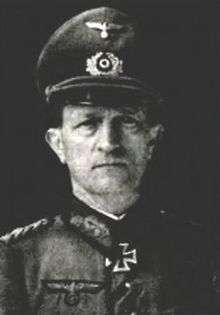Fritz Schlieper
Fritz Schlieper[1] (4 August 1892 – 4 June 1977) was a German military officer who served during World War I and World War II, eventually gaining the rank of Generalleutnant.
Fritz Schlieper | |
|---|---|
 Fritz Schlieper | |
| Born | 4 August 1892 Koldromb, Posen |
| Died | 4 June 1977 (aged 84) Nürnberg |
| Allegiance | |
| Service/ | Army |
| Years of service | 1911–45 |
| Rank | Generalleutnant |
| Commands held | 45. Infanterie-Division |
| Battles/wars | World War I World War II |
| Awards | Knight's Cross of the Iron Cross |
| Relations | Franz Schlieper (brother) |
Biography
Fritz Schlieper was born 4 August 1892 in Koldromb, Posen. In 1911, he joined the German Army. After the First World War, Schlieper continued to serve in the Weimar Republic's Reichswehr and when the Weimar Republic was replaced by Nazi Germany, he remained in the Heer component of the Wehrmacht and from 1935 to 1939 commanded the 17th Artillery Regiment. In 1939, he was promoted to Generalmajor and served as Chief of Staff for Military District XIII and during the Invasion of Poland, served as the Chief of Staff for Frontier Sector Center. From 1939 to 1940, he was also the Quartermaster for the 18th Army.
During Operation Barbarossa, he commanded the 45th Infantry Division in one of the initial battles, the Defense of Brest Fortress. For his part in these battles, he would be awarded the Knight's Cross of the Iron Cross. In 1942, he was transferred to Slovakia to lead German military mission at Slovakian Ministry of Defence. He was released from his position after conflict with Minister General Ferdinand Čatloš.[2] From 1944 until the war's end, he was the Chief of Special Staff II. After the war, Schlieper lived in Nürnberg until his death on 4 June 1977.
Awards
- Iron Cross (1914)
- 2nd class
- 1st Class
- Honour Cross of the World War 1914/1918
- Clasp to the Iron Cross (1939)
- 2nd Class
- 1st Class
- Knight's Cross of the Iron Cross on 27 December 1941 as Generalmajor and commander of the 45. Infanterie-Division
References
Citations
- Scherzer. 2007. p. 665.
- Hrnko, Anton (2002). "Nemecká vojenská misia na Slovensku 1939–1944". História. Archived from the original on 1 May 2009.
Bibliography
- Fellgiebel, Walther-Peer (2000) [1986]. Die Träger des Ritterkreuzes des Eisernen Kreuzes 1939–1945 — Die Inhaber der höchsten Auszeichnung des Zweiten Weltkrieges aller Wehrmachtteile [The Bearers of the Knight's Cross of the Iron Cross 1939–1945 — The Owners of the Highest Award of the Second World War of all Wehrmacht Branches] (in German). Friedberg, Germany: Podzun-Pallas. ISBN 978-3-7909-0284-6.
- Scherzer, Veit (2007). Die Ritterkreuzträger 1939–1945 Die Inhaber des Ritterkreuzes des Eisernen Kreuzes 1939 von Heer, Luftwaffe, Kriegsmarine, Waffen-SS, Volkssturm sowie mit Deutschland verbündeter Streitkräfte nach den Unterlagen des Bundesarchives [The Knight's Cross Bearers 1939–1945 The Holders of the Knight's Cross of the Iron Cross 1939 by Army, Air Force, Navy, Waffen-SS, Volkssturm and Allied Forces with Germany According to the Documents of the Federal Archives] (in German). Jena, Germany: Scherzers Militaer-Verlag. ISBN 978-3-938845-17-2.
| Military offices | ||
|---|---|---|
| Preceded by Generalmajor Gerhard Körner |
Commander of 45. Infanterie-Division 27 April 1941 – 27 February 1942 |
Succeeded by Generalleutnant Fritz Kühlwein |